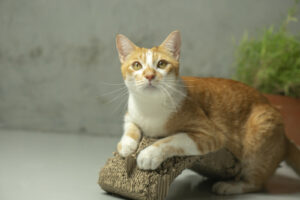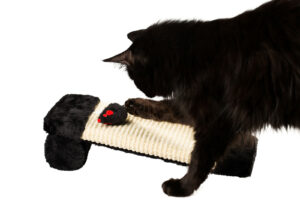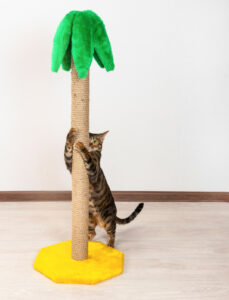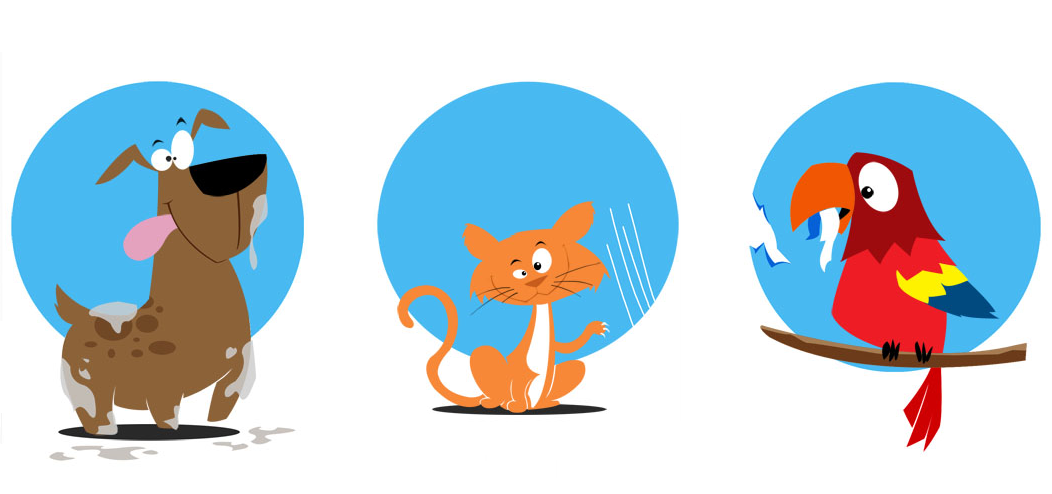Barks Blog
Resolving Destructive Behaviour in Your Pet
By Karolina Westlund Ph.D. of PPG corporate partner Illis Animal Behaviour Consulting
 Destructive behaviour can be extremely frustrating. Image: concept by ILLIS ABC, drawing by Pyrrth
Destructive behaviour can be extremely frustrating. Image: concept by ILLIS ABC, drawing by Pyrrth
Destructive behaviour from your beloved pet can be a nuisance. Assuming there’s not an underlying medical condition or the behaviour isn’t anxiety-related, let’s look at some ways of addressing these types of behaviour, regardless of whether you’re a dog dude, a cat gal or a parrot person.

I’m going to use cat furniture scratching as an example in this post, since I had to address that behaviour very recently.
In cats, scratching serves the purpose of sharpening the claws, territorial marking and defensive behaviour.
So far so good.
It’s when kitty chooses to sink her claws into the pristine vintage sofa that interests collide.
Before all you non-cat people zoom out: this intro serves to emphasize that what may be a problem to you, could actually serve some purpose to the animal.
And problem solving is often about finding other ways for the animal to achieve that purpose.
What to do? First of all, I would advise against punishment, such as spraying water at the cat.
Why? There are several reasons.
- The cat needs to perform scratching.
- She’ll likely just continue clawing when you’re not around – or shift her attention to the matching pristine vintage foot cushion.
- Punishment often has side effects such as aggression or fear, and potentially damaging the relationship between owner and pet.
So, what alternatives are out there?

THE QUICK-FIXES
Declawing is a type of amputation, ethically questionable, and is illegal in many countries under laws against cruelty to animals. Also, declawing often leads to medical complications and behavioural problems such as increased house soiling and biting tendencies.
Puh-lease don’t go there.
A more humane alternative would be gluing nail caps on to the cat’s existing nails to reduce destructive effects of furniture scratching behaviour. However, the application procedure (which needs to be repeated every 4-6 weeks) might be aversive to the animal if he’s not trained. Also, even correctly applied caps might alter the animal’s gait – not to mention the problems associated with incorrectly applied caps.
I haven’t seen any cats wearing caps, so I don’t know if and how their scratching behaviour is affected, but that would also be a concern for me.
On another note, I’d avoid such a solution for cats that defensively scratch people, as that may solve only the human’s problem, but not the cat’s problem. A topic for another post, as such behaviour is probably anxiety-related.
Personally, I’d go for the solution that’s more fun for everybody, teaches the animal something and improves the relationship between owner and pet:
BEHAVIOUR MANAGEMENT SOLUTIONS

Today, I want to share the combined approach I used to solve a scratching situation:
- Teaching an acceptable behaviour,
- Making the unacceptable behaviour less attractive, and
- Arranging the environment.
Let’s have a look at those three approaches.
TEACH AN ACCEPTABLE BEHAVIOUR
OK, so the exquisite sofa is off limits.
Solution: find an alternative that’s at least as attractive.
In my case, we were cat-sitting and our guest decided that she’d either use our living room carpets (downstairs) or the bed (upstairs) for her claw maintenance.
In this film, you see some of the training that I did to teach her to scratch a scratching barrel (that she initially profoundly ignored) rather than the bed or carpet. It didn’t occur to me to film it while I was training it, so later I took out the camera and filmed a few sessions repeating things she’d already learned.
The training sequence looked like this (yes, the target is a butter spreader, a piece of plastic that I grabbed in the kitchen).
- Conditioning to the clicker (clicks mean treats are imminent)
- Teaching the nose-target (getting clicks and treats for touching the target with the nose)
- Generalizing the nose-target (moving to touch the target)
- Switching to paw-target (swatting to touch an out-of-nose-reach target)
- Generalizing to the scratching post (swatting on and then next to target placed on scratching post)
- Stationing the scratching post in target locations. Our guest scratched on waking, so the scratching post needed to be right next to the bed. We found out the hard way that if the scratching post wasn’t there, she lazily chose to do the morning scratch routine on the bed.
- Behaviour maintenance training was not needed since the sisal scratching post was preferred to the bed/carpet, and the behaviour of scratching is rewarding in and of itself (self-reinforcing is the nerd term).
OK, non-cat people, how can you apply this to your pet? Could you use target training to teach an acceptable behaviour?
If your dog can’t dig in the garden, can you think of somewhere else where it would be OK? Can you think of an appropriate alternative, that is at least as attractive to the animal?
MAKE THE UNACCEPTABLE BEHAVIOUR MORE DIFFICULT OR UNATTRACTIVE

Restrict access to areas you want to preserve. Close doors, put attractive objects away – don’t let the animal get unsupervised access.
For the scratchy-cat: make the unwanted behaviour less likely by making scratching surfaces unappealing through a change of texture. In the case of cats, they prefer sharpening their claws on certain textures. By changing texture, you may change the motivation to scratch in that particular location. For instance, covering the inappropriate scratching areas with a cloth for a while – we used an old sheet. The Sticky Paws scratch control strips get mixed reviews, some people like them, some not; for some they don’t deter the scratching, and leave sticky residue on furniture when removed.
Cats often dislike citrus smells. An option often suggested is to use a lemon spray on off-limit-areas to reduce their attractiveness. Using deterrent smells is an approach that I’m not all too keen on for two reasons:
- The bad smell would annoy the cat even if there is no misbehaviour, and
- I wouldn’t know at what distance the cat could perceive it.
I wouldn’t want my innocent cat to have to avoid her favorite resting spot because the oblivious human can’t perceive that terrible smell originating from the off-limits sofa a few meters away.
The idea behind using deterrents is to create contrast: the off-limit site smelling so bad that the cat will choose another site.
But contrast need not be from nasty to neutral, it could be from neutral to nice, too!
Some cats go crazy over catnip and rub and scratch at the smell: try this for the scratching post instead.
The off-limits site doesn’t have to smell bad if the scratching post smells good. The contrast between the options will likely influence her decision.
SIMPLIFY THE RIGHT CHOICE

You can help her make that choice by setting up the environment.The animal is making a choice. “Should I dig my claws into the pristine sofa, or the sisal scratching post?”
Setting up the environment means both facilitating the desired behaviour by placing attractive scratching posts where they are needed (such as nearby when waking up), making sure they smell enticingly.
Setting up the environment also means changing the accessibility / texture of the unacceptable scratching objects, at least until the desired behaviour is an established habit.
The animal is making a choice – our task as trainers is to make the right choice obvious, simple, and rewarding (nerd term: reinforcing).
OTHER SPECIES, OTHER BEHAVIOURS – SAME PRINCIPLES
The line of thinking is the same regardless of species, but the details will be different.
Is your dog digging up the back yard, or your parrot chewing through all your paneling? Assuming the behaviour isn’t anxiety-based or due to a medical condition, consider these three questions:
- How can you offer acceptable alternatives that are at least as attractive as what the animal is currently doing?
- How can you make the unacceptable behaviour more difficult or unappealing, without resorting to punishment?
- How can you help make the right choice more obvious, easier, and more rewarding?
Behaviour management solutions may not be quick fixes, but they work, improve relationships and empowers animals – and owners.
***
Tucker & Tucker (1988). Catnip and the catnip response
Note from the Author: I teach online courses about how to get happy animals that thrive with humans, and foundational as well as advanced animal training going into extreme nerdy detail. Check out the courses!
About the Author
Karolina Westlund helps pet owners and people working professionally with animals to get happier, reasonably well behaved animals that thrive in the care of humans. She teaches animal behaviour management through blog posts, the odd Facebook live session or webinar, as well as more extensive online courses. She is an associate professor of Ethology at Stockholm University, Sweden and sometimes publishes scientific articles related to enrichment, animal training, and well-being. She will be the keynote speaker at PPG’s sixth annual summit in Kanab, Utah on September 20-25, 2020.


